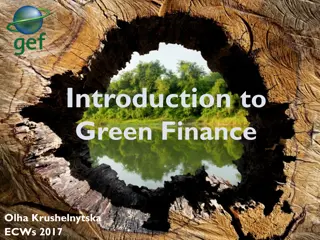Climate Finance as a Catalyst for Private Sector Financing in Latin America
Climate finance plays a vital role in leveraging private sector financing for energy projects in Latin America. Public and private sources, along with intermediaries, contribute to a significant portion of climate finance flows. Examples include ministries, government agencies, development banks, and institutional investors. By utilizing financial instruments and specialized knowledge, climate finance helps drive investment in mitigation and adaptation measures in the region.
Uploaded on Sep 17, 2024 | 1 Views
Download Presentation

Please find below an Image/Link to download the presentation.
The content on the website is provided AS IS for your information and personal use only. It may not be sold, licensed, or shared on other websites without obtaining consent from the author.If you encounter any issues during the download, it is possible that the publisher has removed the file from their server.
You are allowed to download the files provided on this website for personal or commercial use, subject to the condition that they are used lawfully. All files are the property of their respective owners.
The content on the website is provided AS IS for your information and personal use only. It may not be sold, licensed, or shared on other websites without obtaining consent from the author.
E N D
Presentation Transcript
Climate Finance as a Catalyst Climate Finance as a Catalyst for Leveraging Private Sector for Leveraging Private Sector Financing in the Energy Sector: Financing in the Energy Sector: Examples in Latin America Examples in Latin America Carlos A. Cordova Carlos A. Cordova UNFCCC LAC Regional Workshop on NAMAs (Nationally UNFCCC LAC Regional Workshop on NAMAs (Nationally Appropriate Mitigation Actions) Appropriate Mitigation Actions) September 14-15, 2015 Santiago, Chile
Overview of Climate Finance Overview of Climate Finance Climate Finance: financial resources invested in mitigation and adaptation measures through financial instruments including loans, grants and guarantees, which have helped leverage additional private finance Sources: public, private & intermediaries Instruments: range of tools, mechanisms and modalities Uses: mitigation vs. adaptation Readiness: plan, access, deliver, monitor
Public Sources & Intermediaries Public Sources & Intermediaries US$ 137 Billion, or 42%, of total $331 Billion climate finance flows in 2014 (Source: CPI Global Landscape of Climate Finance, 2014) Ministries & Government Agencies Bilateral Aid agencies Export Credit Agencies UN institutions Development Finance Institutions Multilateral Development Banks (MDB) National Development Banks (NDB) Bilateral Financial Institutions (BFI) Climate Funds Global Environment Facility (GEF) Adaptation Fund (AF) Climate Investment Funds (CIF) Green Climate Fund (GCF) National strategies & policy frameworks conducive to investment Technical assistance, financial instruments & specialized knowledge Grants & loans at concessional terms (finite lifetime, sectoral focus)
Private Sources & Intermediaries Private Sources & Intermediaries US$ 193 Billion, or 58%, of total $331 Billion climate finance flows in 2014 Project Developers: national/regional utilities, independent power producers, renewable energy Corporate Actors: manufacturers, corporate end-users Private Households: family level economic entities, high net worth individuals Institutional Investors: insurance companies, pension funds, endowments Commercial Financial Institutions Private Equity, Venture Capital & Infrastructure Funds
Uses of Climate Financing Uses of Climate Financing Renewable energy generation Energy efficiency in industry and buildings Sustainable transport AFOLU & livestock management 91% mitigation Water supply management Climate-resilient infrastructure Coastal protection Disaster risk reduction AFOLU & natural resource management 7% adaptation
Climate Financing Instruments to Leverage Climate Financing Instruments to Leverage Private Sector Investment Private Sector Investment 1. Policy Incentives: Feed-in tariffs Tradeable certificates Tax incentives Clean energy subsidies Risk Management: Guarantees Insurance policies Contract-based instruments Grants: Cash transfers In-kind support Low-cost project debt: Concessional loans Capital Instruments at commercial terms: Project-level market rate debt Project-level equity Balance sheet financing 2. Address investor-specific needs Align public and private interests 3. Enable scaled-up investments 4. 5.
Climate Finance Readiness Climate Finance Readiness Capacity of countries to plan for, access, deliver and monitor climate finance, both international and domestic, in ways that are catalytic and fully integrated with national development priorities and achievement of the MDGs (Source: UNDP, 2012)
Climate Finance Readiness Process Climate Finance Readiness Process Plan Access Deliver Monitor National capacity to combine vs. blend resources for access to wider range of financial instruments Capacity to deliver finance, implement and execute activities at the regional, national or local level. National capacities and systems for monitoring and evaluating the impact of climate finance on mitigation and adaptation goals Capacity to plan for the supply, management and use of climate finance resources Tracking financial expenditures on climate change activities within and outside the national budget Effective: assess climate finance flows Traditional: multilateral implementing entities (e.g. GEF) National system: financial oversight & management Direct: accredited entities from recipient countries (e.g. Adaptation Fund) Efficient: prioritize climate actions and match priorities with resources Execution services: procurement, contracting, hiring Database systems & information- collection processes Enhanced: national fund management with international fund oversight (e.g. GCF) Coordination among entities: macro level alignment with national development strategies Equitable: integrate resources over time Developing indicators & assessment processes
How Can We Help? How Can We Help?
Climate Finance Solutions through E Climate Finance Solutions through E- -learning learning
Climate Finance Solutions through Collaborative Partnerships LAC LEDS Network: Launched in Alajuela, Costa Rica (Nov 2012), followed by webinar series on LEDS for the Spanish-speaking LEDS community and a web-based open community of practice to promote information sharing, networking and online collaboration among Latin American LEDS practitioners and policymakers LEDS-LAC-final.jpg
Climate Finance Solutions through Global & Climate Finance Solutions through Global & Regional Fora Regional Fora Latin American & Caribbean Carbon Forum: Annual event that brings together a range of private and public sector stakeholders to explore solutions for mobilizing climate finance and to discuss alternative pathways to low carbon development in the region Carbon Expo: Largest global, multi-sectoral climate finance and carbon market platform for facilitating innovation, promoting enhanced understanding of new policy instruments and identifying ways to access and leverage climate finance.
Other World Bank Climate Finance Readiness Other World Bank Climate Finance Readiness Initiatives Initiatives
Climate Investment Funds: CTF Climate Investment Funds: CTF The CTF fund it s a $5.3 billion Clean Technology Fund (CTF), a funding window of the Climate Investment Funds, to provide scaled-up financing to middle income countries to contribute to the demonstration, deployment and transfer of low carbon technologies with a significant potential for long-term greenhouse gas emissions savings. The CTF differs significantly from other mitigation-focused, multilateral climate instruments by focusing on drive down technology costs, and stimulate private sector participation, and catalyze transformative change that can be replicated elsewhere.
CTF and the Private Sector CTF and the Private Sector The private sector is a key player in the CTF, with 30% of all investment plan allocations going to private sector projects and programs specified in these plans. In 2013, the CIF embarked on new financing paths that put greater emphasis on reducing barriers to private sector participation. The Dedicated Private Sector Programs (DPSP) under the CTF were created to finance operations that can deliver scale and speed while maintaining country priorities. The DPSP are currently in their second phase and have allocated a total of $ 508.5 million to eight programs reaching countries as diverse as Chile, Colombia, Indonesia, Mexico, Turkey, Haiti , Honduras, Ghana, and Mali.
Chiles Solar Power and Energy Efficiency Chile s Solar Power and Energy Efficiency Example: Example: The government of Chile has designed a plan that taps $200 million from the Clean Technology Fund (CTF) ) to address key risk, cost, and liquidity barriers by providing concessional financing and technical assistance intended to stimulate the development of Chile s solar power and energy efficiency markets, therefore stimulating, securing and enhancing private sector investment.
Thank you! For more info, contact: Carlos Cordova ccordova@worldbank.org World Bank Group 1701 18th St NW Washington, DC 20006























